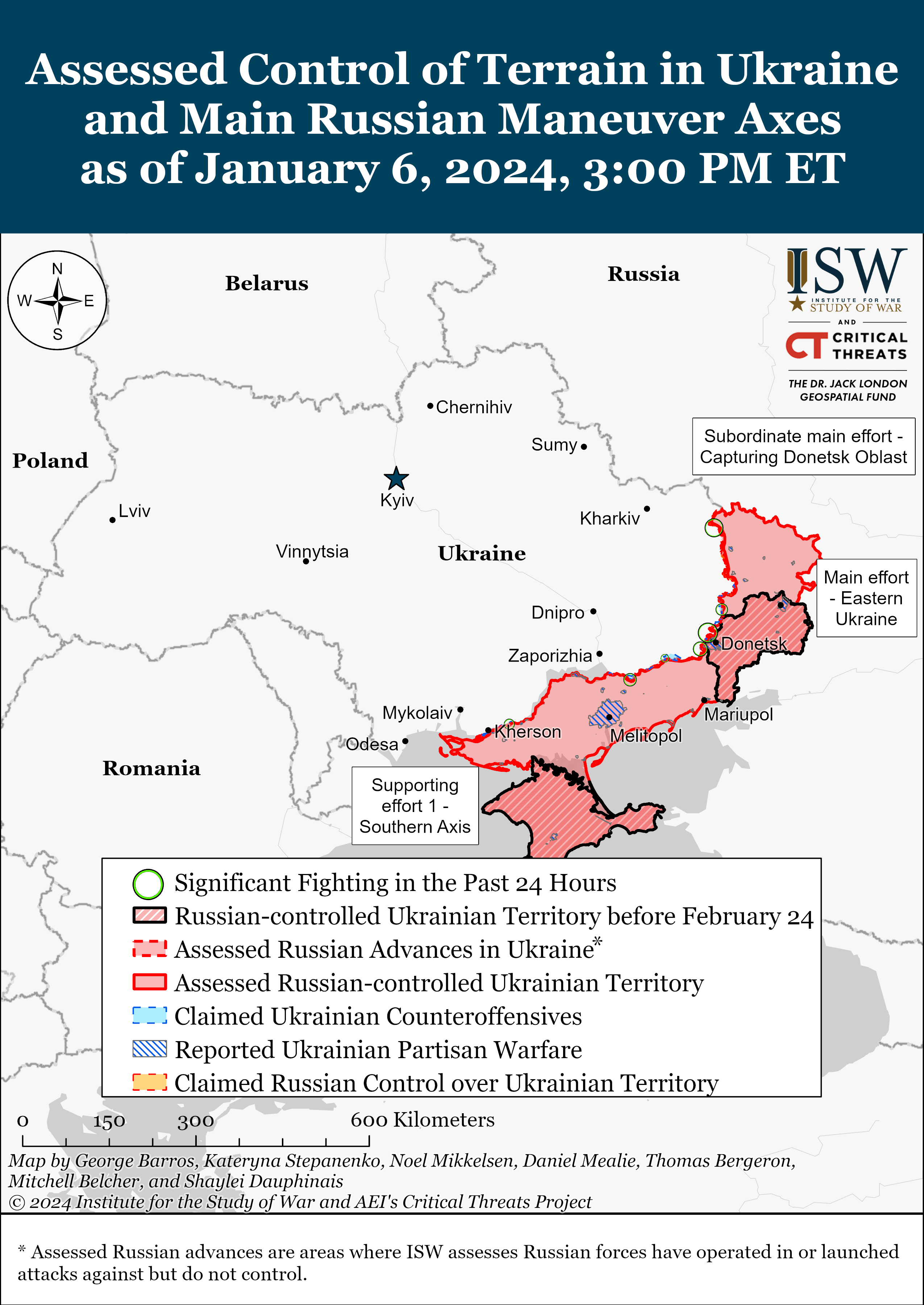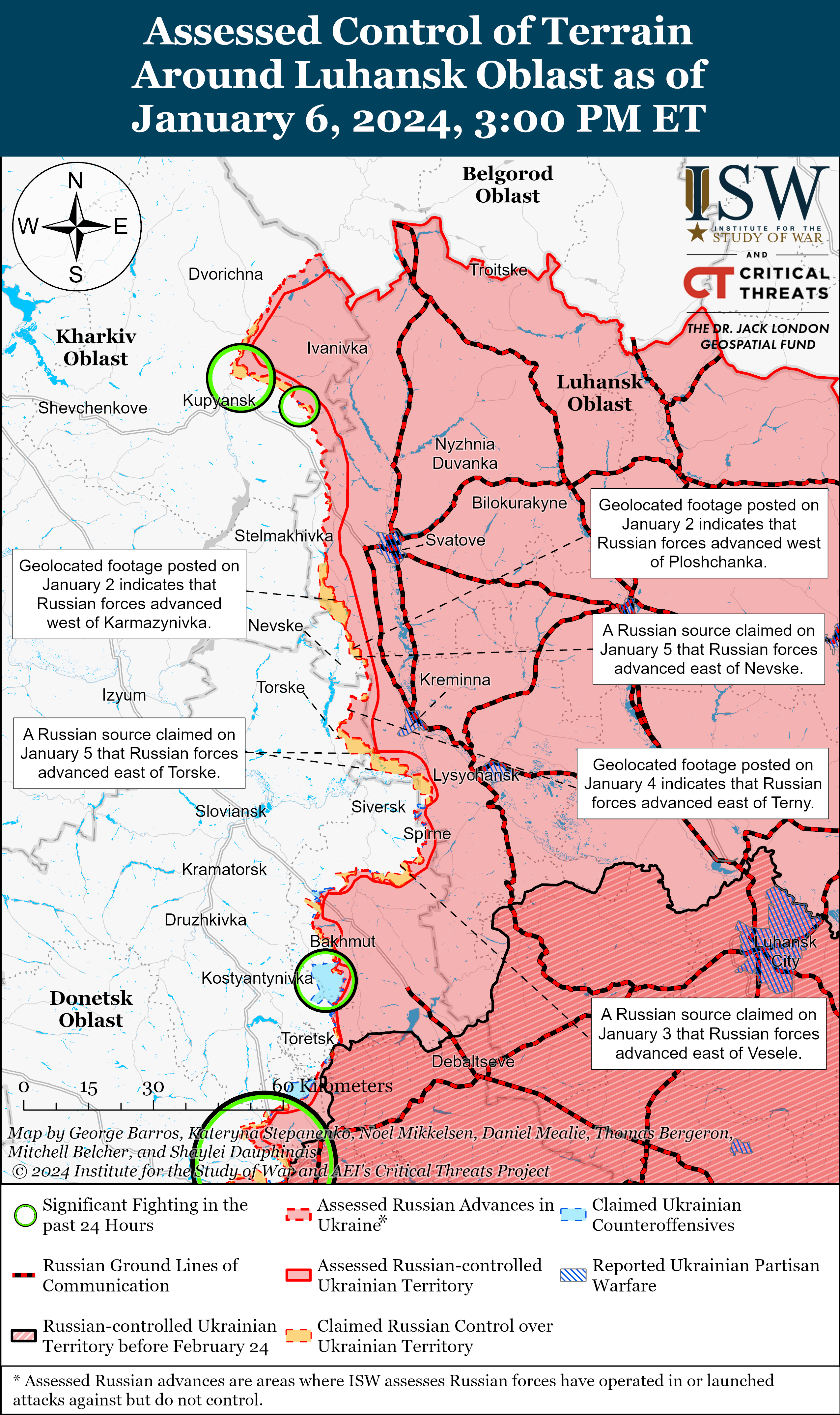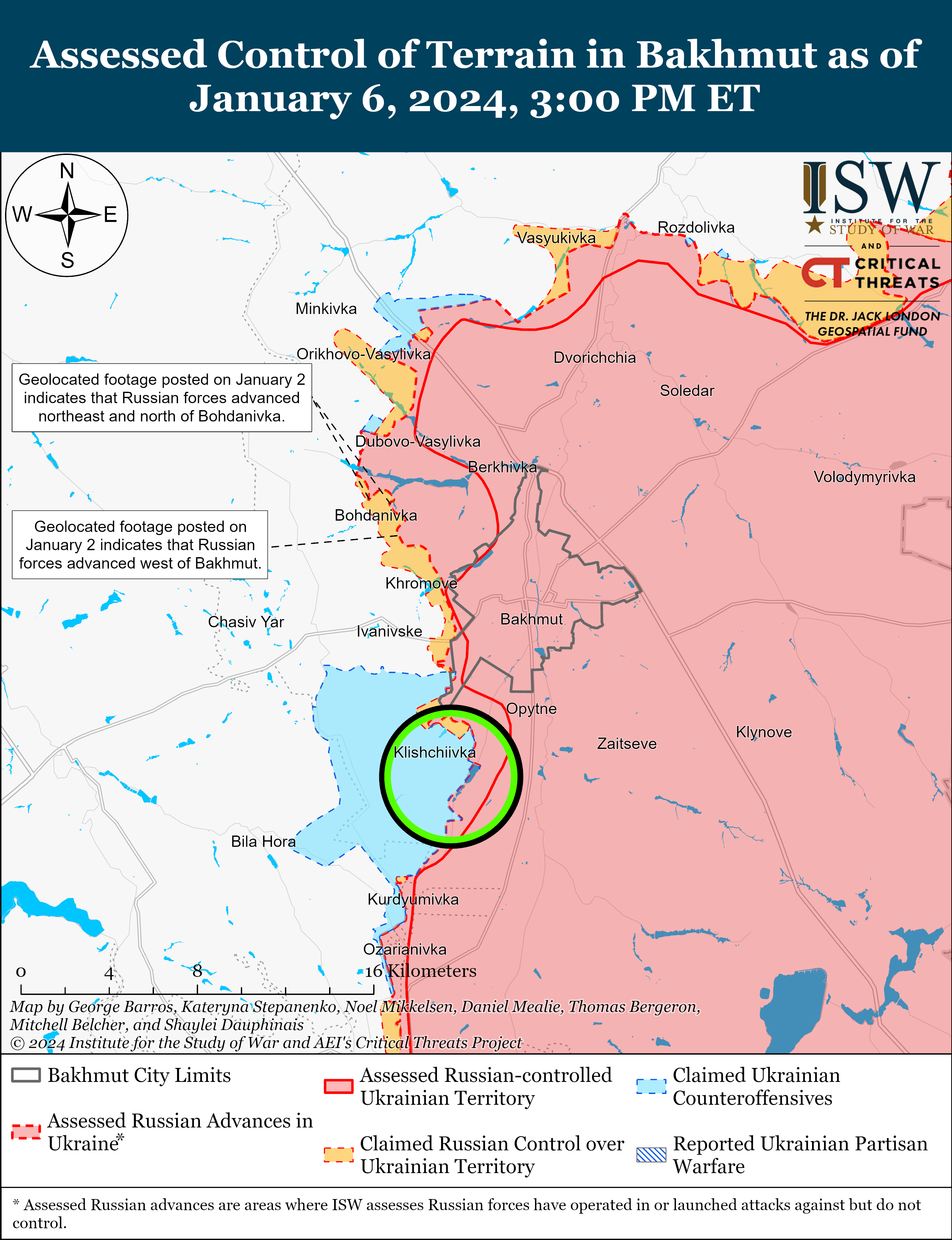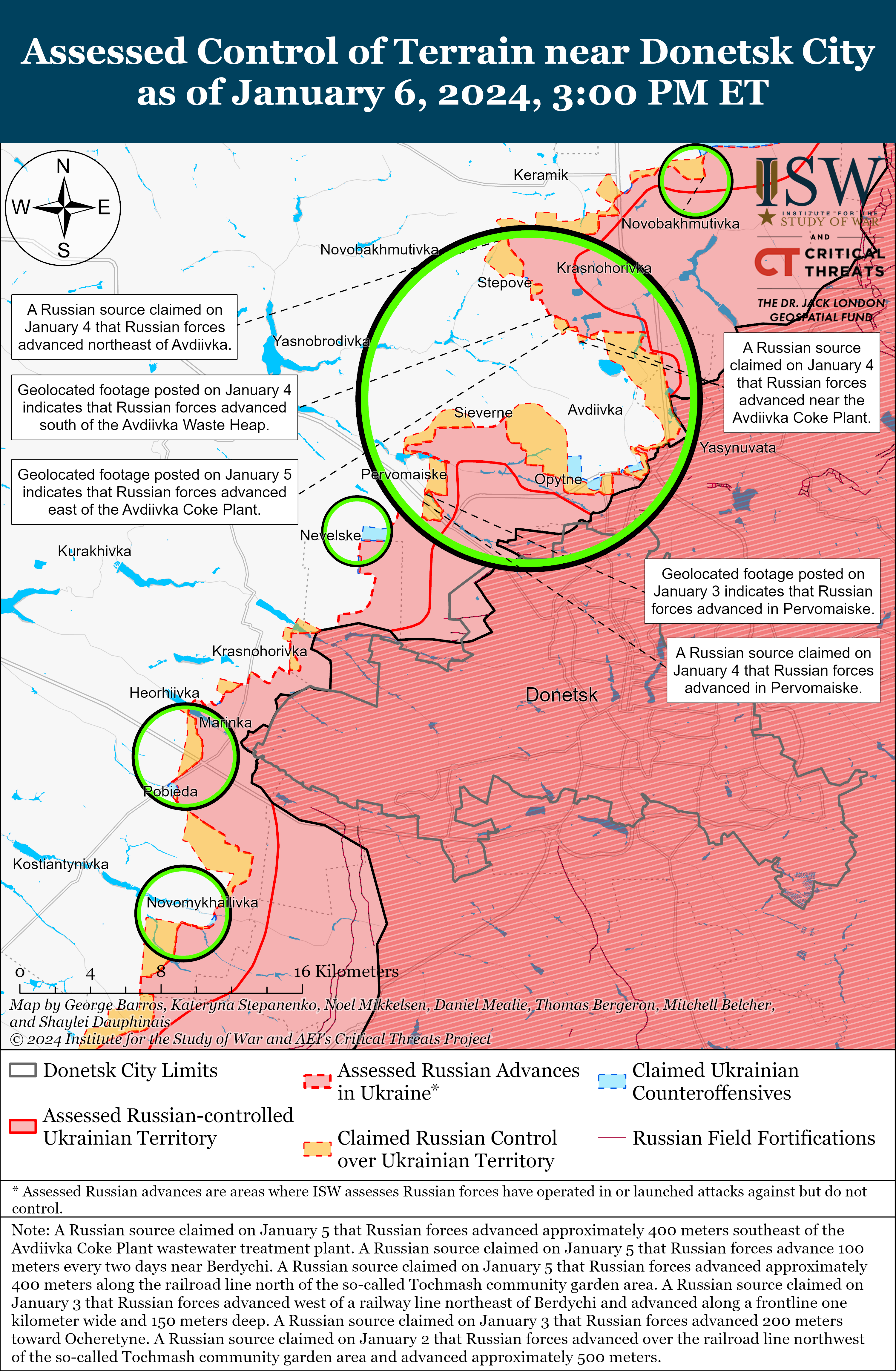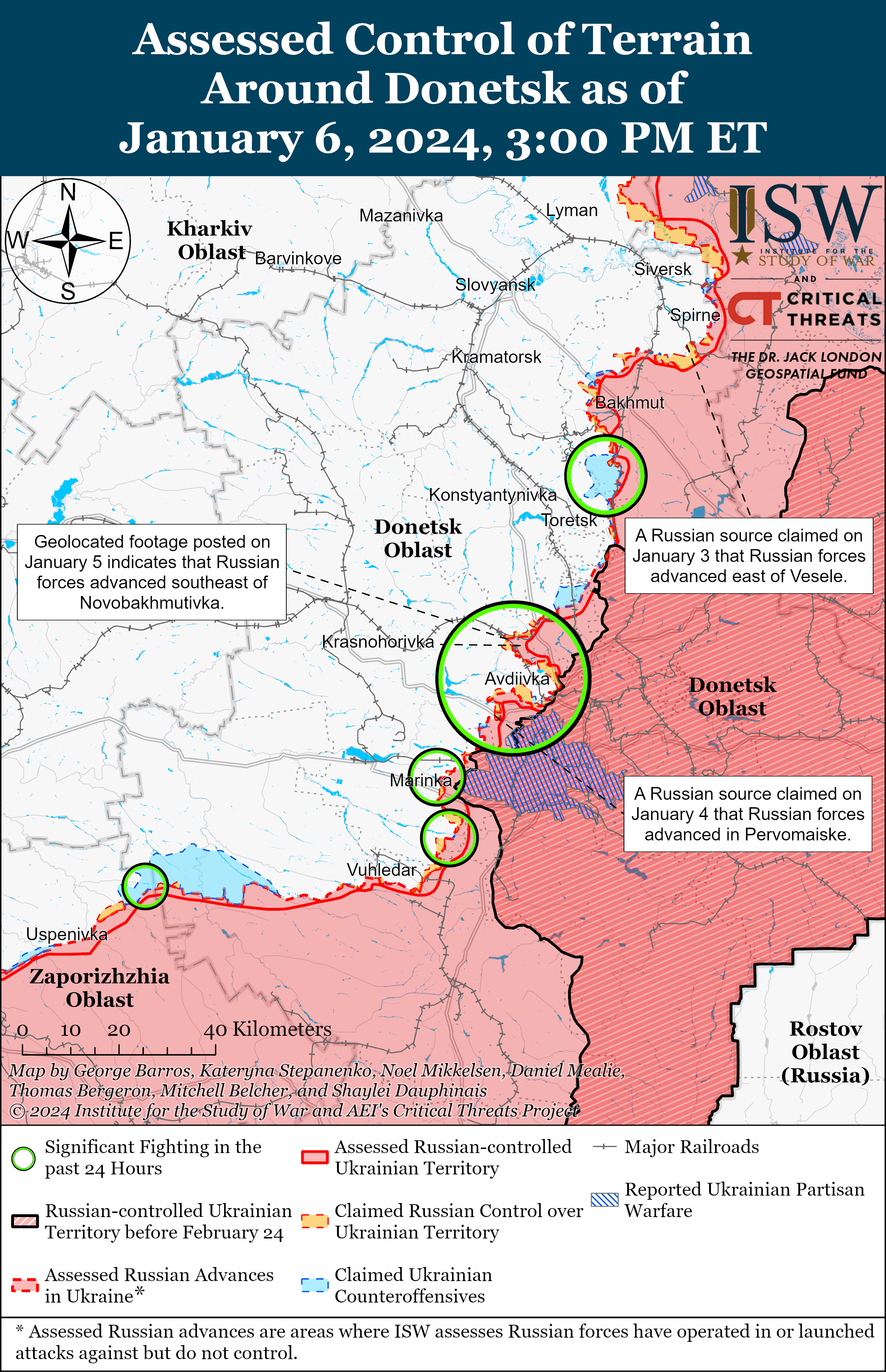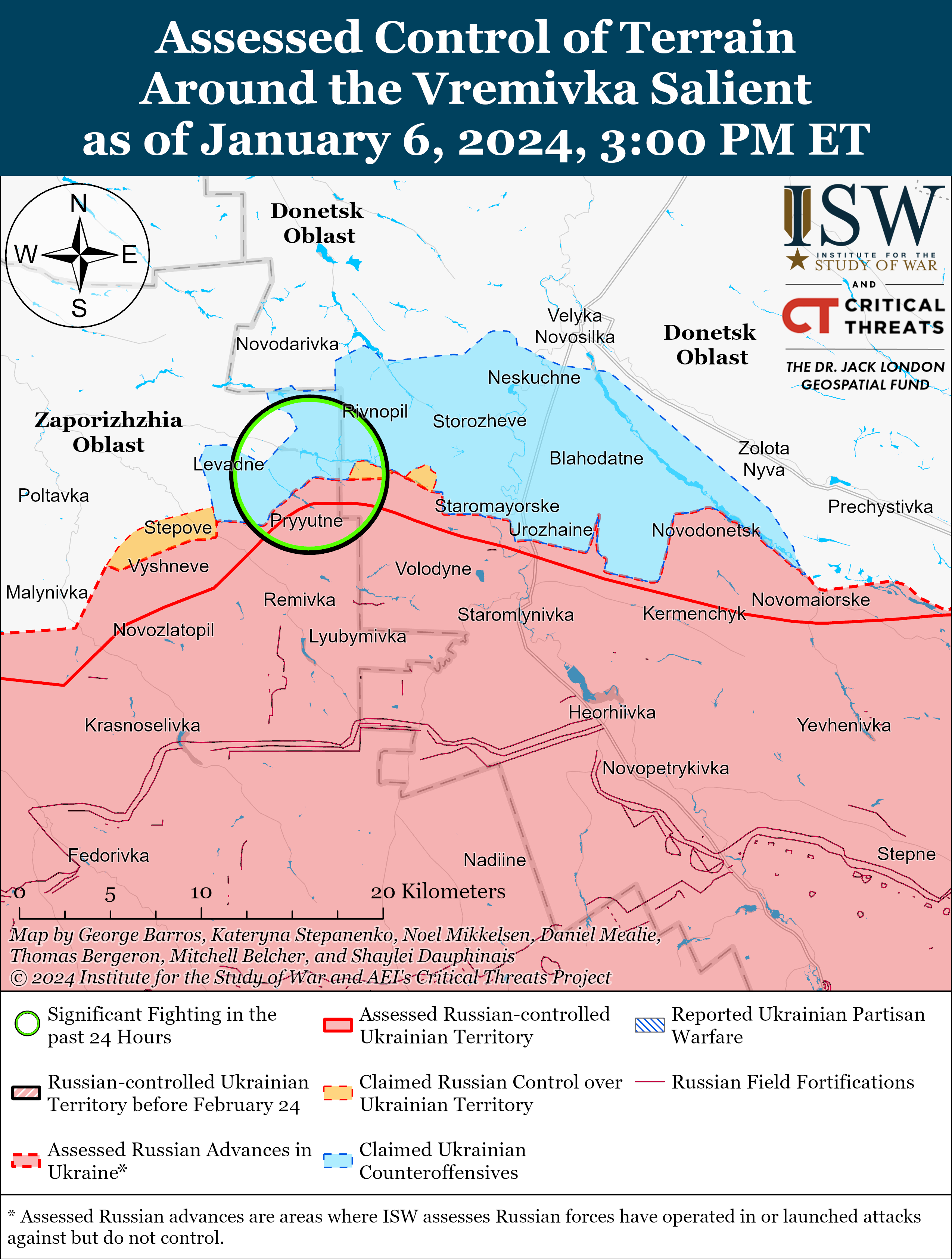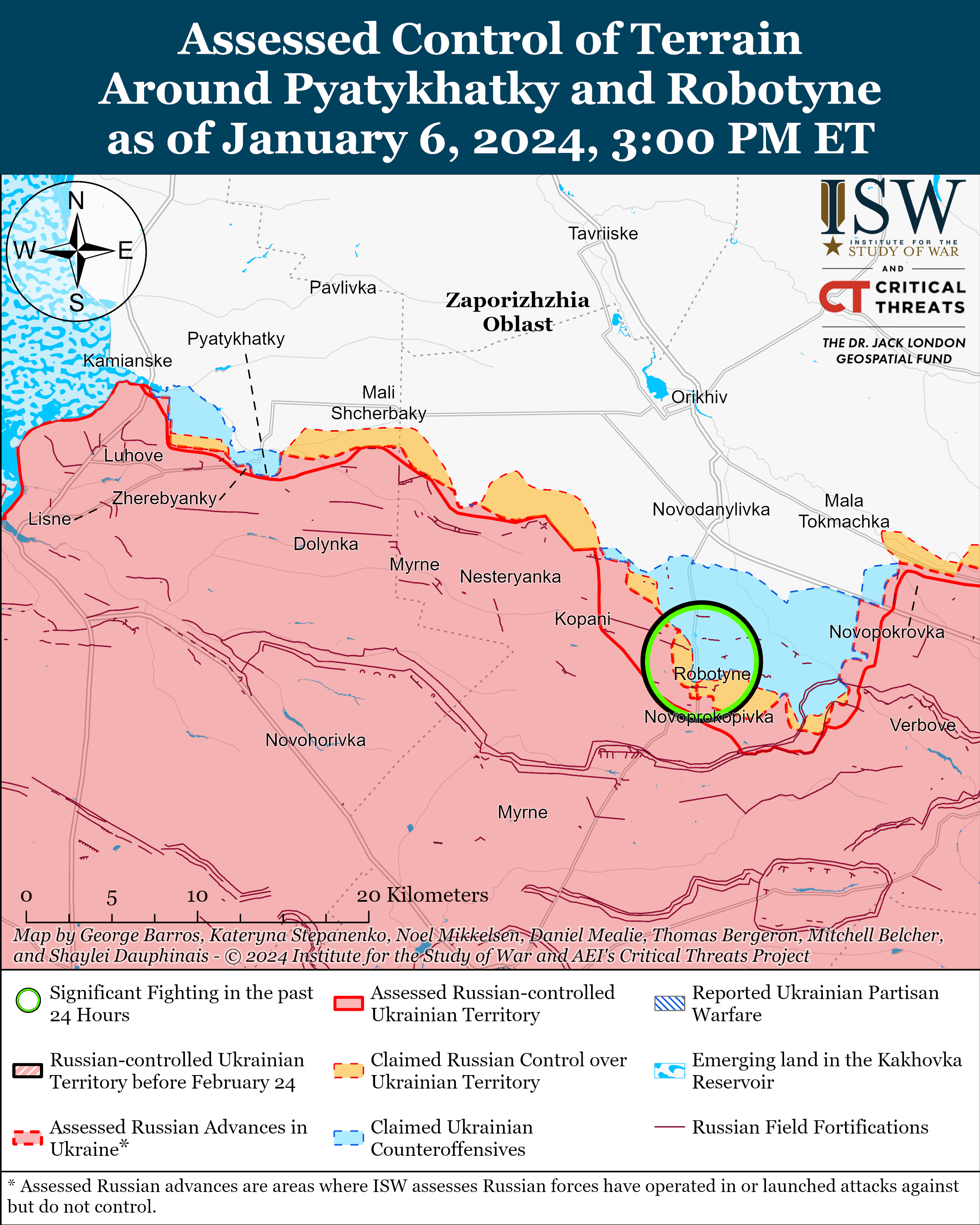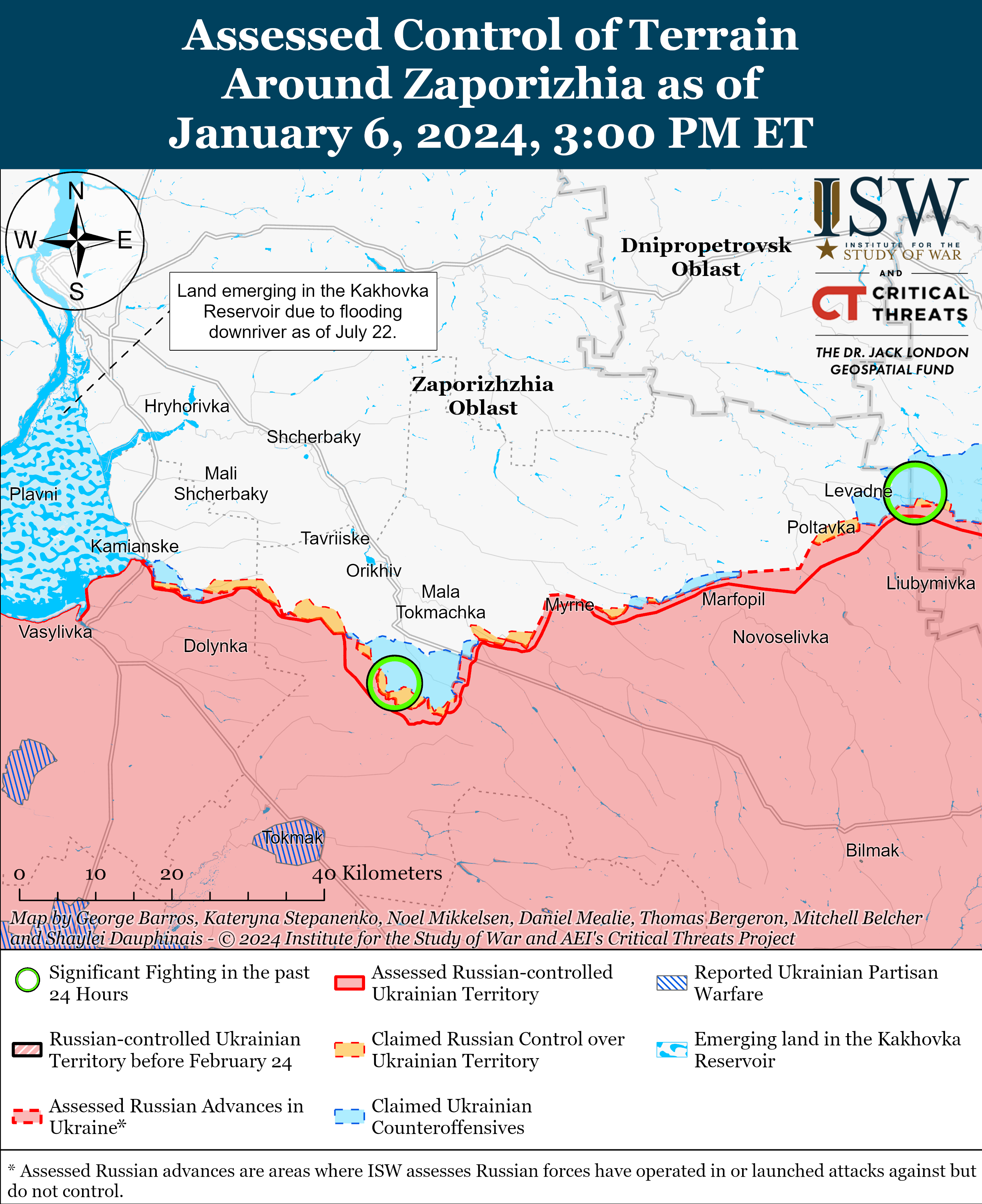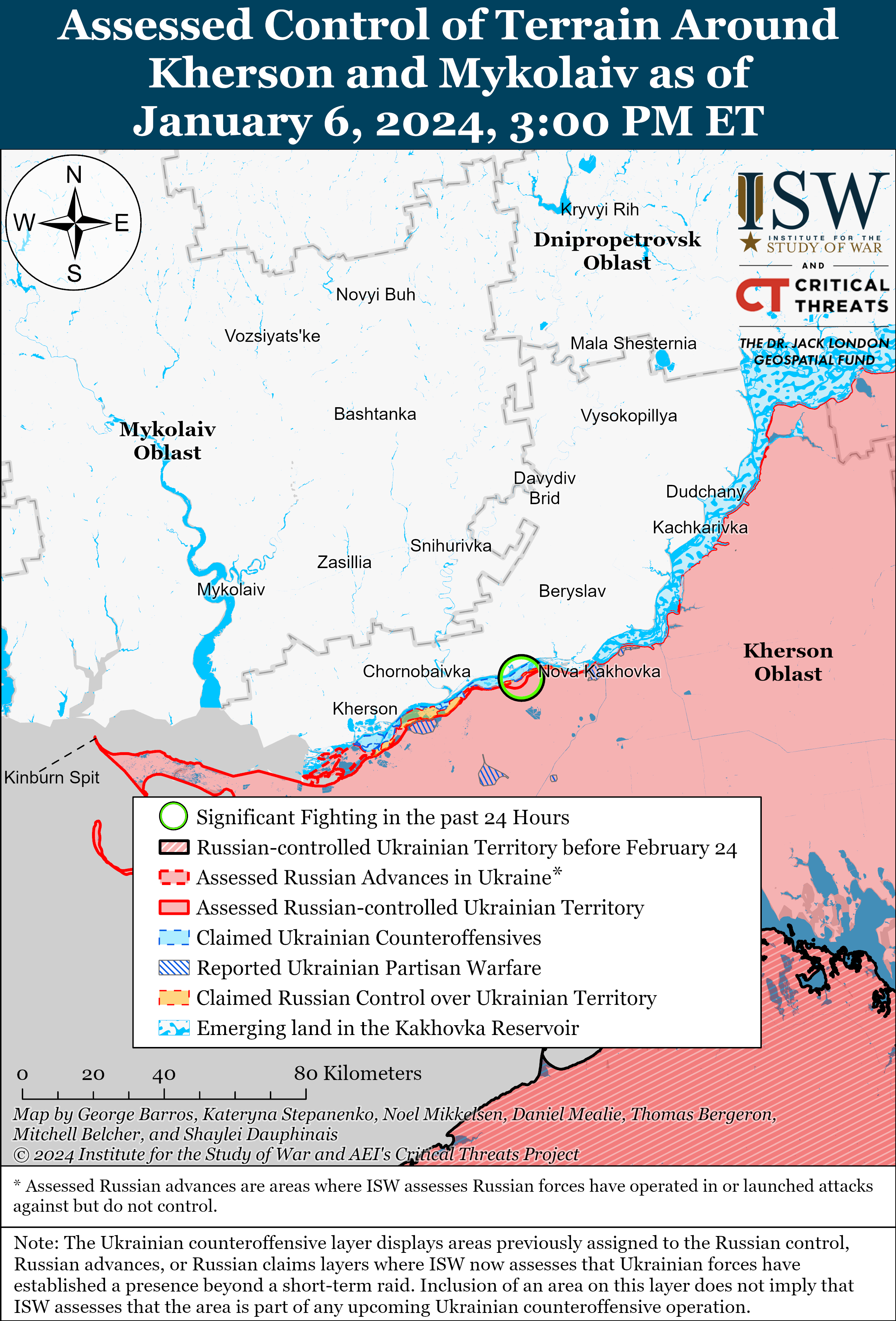Russian Offensive Campaign Assessment, January 6, 2024
Christina Harward, Riley Bailey, Grace Mappes, Karolina Hird, and Frederick W. Kagan
January 6, 2024, time 3:50pm ET
Click here to see ISW’s interactive map of the Russian invasion of Ukraine. This map is updated daily alongside the static maps present in this report.
Click here to see ISW’s 3D control of terrain topographic map of Ukraine. Use of a computer (not a mobile device) is strongly recommended for using this data-heavy tool.
Click here to access ISW’s archive of interactive time-lapse maps of the Russian invasion of Ukraine. These maps complement the static control-of-terrain map that ISW produces daily by showing a dynamic frontline. ISW will update this time-lapse map archive monthly.
Note: The data cut-off for this product was 12:00pm ET on January 6. ISW will cover subsequent reports in the January 7 Russian Offensive Campaign Assessment.
Ukrainian forces are conducting a multi-day strike campaign against Russian military targets in occupied Crimea and have successfully struck several targets throughout the peninsula. Russian sources claimed that Ukrainian forces struck an administrative building at the Russian airfield in occupied Saky, Crimea with up to four Storm Shadow cruise missiles on the night of January 5 to 6.[1] The Russian Ministry of Defense (MoD) claimed that Russian forces destroyed five Ukrainian drones and four missiles over the Black Sea and Crimea on the night of January 5 to 6 and six Ukrainian Neptune missiles over the northwestern Black Sea on January 6.[2] Ukrainian Air Force Commander Lieutenant General Mykola Oleshchuk thanked Ukrainian pilots for successfully striking targets at the Saky airfield but did not specify if he was referring to Ukrainian strikes on January 4, 5, or 6.[3] Oleshchuk posted satellite imagery showing the target of the reported successful Ukrainian strike at the Saky airfield, although ISW is currently unable to identify what the target was.[4] The Ukrainian Main Military Intelligence Directorate (GUR) stated on January 6 that the GUR, Ukrainian Air Force, and Ukrainian forces conducted a complex special operation that struck Russian radar positions at the Saky airfield and an equipment depot near Hryshyne (60km northeast of Yevpatoria) on January 4.[5] GUR posted satellite imagery showing damage to the Russian ammunition depot near Hryshyne.[6] Ukrainian officials and sources have reported that Ukrainian forces have also struck an air defense radar system and a communications center in Yevpatoria responsible for coordinating Russian air defense operations in occupied Crimea, ammunition warehouses near Pervomaiske (82km north of Simferopol), and a Russian command post near Sevastopol in strikes since January 4.[7] Ukrainian and Russian reporting indicates that Ukrainian missiles and drones are penetrating Russian air defenses in occupied Crimea and have successfully struck some intended targets.
A prominent Kremlin-affiliated Russian milblogger claimed that Ukrainian forces are conducting strikes aimed at degrading the Russian air defense umbrella over occupied Crimea.[8] ISW will not assess the intent of the current Ukrainian strike campaign against Russian rear areas in occupied Crimea at this time. Ukrainian forces conducted a strike campaign against Russian military infrastructure, headquarters, logistics routes, and Black Sea Fleet (BSF) assets in summer 2023 that pushed Russian naval operations out of the western part of the Black Sea and that aimed to degrade the Russian military’s ability to use Crimea as a staging and rear area for defensive operations in southern Ukraine.[9]
A Russian milblogger argued that Russian forces need to improve planning and coordination at the tactical and operational levels so that Russian offensive operations can break out of the current positional warfare in Ukraine.[10] The milblogger stated that Russian forces should not concentrate the attacking formations – especially mechanized units – in the intended directions of attack due to the threat of Ukrainian strikes against large force accumulations. The milblogger stated that Russian forces must precede any breakthrough with preparatory artillery fire against both the objective that Russian forces are attacking and Ukrainian artillery firing positions in a wider area within range of the objective. The milblogger emphasized the importance of coordinating the actions of various units, including allocating individual artillery units to cover certain sectors of the front and allocating some ammunition for preparing the battlefield while reserving ammunition for after the assault has begun. The milblogger noted that the attacking Russian units need to maintain uninterrupted communications and be able quickly to exchange intelligence data – coordination that the Russian military units on multiple fronts have struggled with in recent months, as ISW has frequently reported.[11] The milblogger observed that the Russian military command must understand and incorporate the battlefield geography and the array of Ukrainian forces and defenses in the area into battle plans.[12] ISW has not observed any indication that Russian forces have improved their ability to plan and coordinate offensive operations given the ongoing costly and disorderly Russian offensive effort near Avdiivka. Russian forces in Ukraine have proven capable of successfully adapting limited aspects of their operations or defensive efforts in certain sectors of the front, however.[13] It is unclear if the Russian command will be able to improve tactical and operational coordination across larger sectors of the front as the milblogger called for.
Western provision of air defense systems and missiles to Ukraine in the near- and medium-term remain crucial for Ukraine’s development of a defense industrial base (DIB) that can sustain Ukraine’s war effort against Russia in the long term. Ukrainian Deputy Defense Minister Lieutenant General Ivan Havrylyuk stated on January 6 that the Ukrainian Ministry of Defense (MoD) completed the approvals process for about 15 new types of weapons and military equipment, including robotic systems, drones, electronic warfare (EW) systems, engineering equipment, a modernized armored fighting vehicle, and anti-tank guided missiles systems and ammunition, to the Ukrainian Armed Forces in the first week of 2024.[14] This approvals process allows the Ukrainian MoD to make agreements with defense manufacturers and to issue the weapons to the Ukrainian military. Havrylyuk stated that the Ukrainian Armed Forces completed the approvals process for more than 200 types of domestically produced weapons and military equipment in 2023.
US State Department Spokesperson Matthew Miller stated on January 4 that the provision of US aid remains “critical” because Ukraine is not yet able to defend itself but will not need to continue at current levels because Ukraine is working to expand its defense industry to be able to “stand on its own feet.”[15] ISW previously assessed that recent large-scale Russian strikes targeted Ukrainian industrial facilities in an effort to degrade Ukraine’s ability to develop its DIB and sustain its war effort against Russia.[16] The configuration of Ukraine’s air defense umbrella, including Western-provided air defense systems, in targeted areas have proven vital to Ukraine’s ability to defend against Russian missiles, particularly ballistic missiles.[17] Ukrainian Commander-in-Chief General Valerii Zaluzhnyi stated on January 2 that Patriot systems enabled Ukrainian forces to down a record number of 10 Kinzhal hypersonic missiles during Russian strikes on January 1-2.[18] The New York Times (NYT) reported on January 6 that White House and Pentagon officials warned that the US will soon be unable to supply Ukraine with Patriot air defense missiles, however.[19]
The Danish Ministry of Defense (MoD) announced on January 6 that it is delaying its first delivery of six F-16 fighter jets to Ukraine for up to six months.[20] Danish officials previously stated that Denmark would deliver F-16s to Ukraine around the start of 2024, and a recent Estonian MoD strategy document identified Denmark as committed to delivering F-16s to Ukraine before the end of 2023.[21]
Key Takeaways:
- Ukrainian forces are conducting a multi-day strike campaign against Russian military targets in occupied Crimea and have successfully struck several targets throughout the peninsula.
- A Russian milblogger argued that Russian forces need to improve planning and coordination at the tactical and operational levels so that Russian offensive operations can break out of the current positional warfare in Ukraine.
- Western provision of air defense systems and missiles to Ukraine in the near- and medium-term remain crucial for Ukraine’s development of a defense industrial base (DIB) that can sustain Ukraine’s war effort against Russia in the long-term.
- The Danish Ministry of Defense (MoD) announced on January 6 that it is delaying its first delivery of six F-16 fighter jets to Ukraine for up to six months.
- Russian and Ukrainian forces continued positional engagements along the entire line of contact on January 6.
- The Russian Ministry of Defense (MoD) continues efforts to incentivize service with the Russian military by advertising support for housing.
- Russian occupation authorities are struggling to provide basic services to residents of occupied areas of Ukraine.
We do not report in detail on Russian war crimes because these activities are well-covered in Western media and do not directly affect the military operations we are assessing and forecasting. We will continue to evaluate and report on the effects of these criminal activities on the Ukrainian military and the Ukrainian population and specifically on combat in Ukrainian urban areas. We utterly condemn Russian violations of the laws of armed conflict and the Geneva Conventions and crimes against humanity even though we do not describe them in these reports.
- Russian Main Effort – Eastern Ukraine (comprised of two subordinate main efforts)
- Russian Subordinate Main Effort #1 – Capture the remainder of Luhansk Oblast and push westward into eastern Kharkiv Oblast and encircle northern Donetsk Oblast
- Russian Subordinate Main Effort #2 – Capture the entirety of Donetsk Oblast
- Russian Supporting Effort – Southern Axis
- Russian Mobilization and Force Generation Efforts
- Russian Technological Adaptations
- Activities in Russian-occupied areas
- Russian Information Operations and Narratives
Russian Main Effort – Eastern Ukraine
Russian Subordinate Main Effort #1 – Luhansk Oblast (Russian objective: Capture the remainder of Luhansk Oblast and push westward into eastern Kharkiv Oblast and northern Donetsk Oblast)
Russian and Ukrainian forces continued positional engagements along the Kupyansk-Svatove-Kreminna line on January 6. Ukrainian and Russian sources stated that positional fighting continued northeast of Kupyansk near Synkivka; east of Kupyansk near Petropavlivka and Ivanivka; west of Kreminna near Terny, Torske, and Yampolivka; and south of Kreminna near Dibrova and the Serebryanske forest area.[22] Ukrainian Luhansk Oblast Military Administration Head Artem Lysohor stated that Russian forces intensified shelling on Ukrainian positions near Nevske (northwest of Kreminna) and Bilohorivka (12km south of Kreminna) and are raising reserves in the area in preparation for new assaults.[23] Elements of the Russian “Veter 177” unit of the 16th Spetsnaz Brigade (Russian General Staff Main Directorate or GRU) are reportedly operating in the Kupyansk direction and elements of the 7th Motorized Rifle Brigade (2nd Luhansk People’s Republic [LNR] Army Corps) are operating near Bilohorivka.[24]
Russian sources claimed that Ukrainian forces struck infrastructure objects in occupied Kadiivka, Luhansk Oblast with HIMARS rockets on January 6.[25]
Russian Subordinate Main Effort #2 – Donetsk Oblast (Russian objective: Capture the entirety of Donetsk Oblast, the claimed territory of Russia’s proxies in Donbas)
Ukrainian and Russian forces continued positional engagements near Bakhmut on January 6, but there were no confirmed changes to the frontline in this area. Ukrainian and Russian sources stated that positional engagements continued northeast of Bakhmut at positions west of Soledar; northwest of Bakhmut near Bohdanivka; west of Bakhmut near Khromove; and southwest of Bakhmut at positions near Andriivka, northwest of Klishchiivka, and north of Kurdyumivka.[26] Elements of the Russian 98th Airborne (VDV) Division, including the 331st VDV Regiment, and the 58th Spetsnaz Battalion (1st Donetsk People’s Republic [DNR] Army Corps) are reportedly operating in the Bakhmut direction.[27] Elements of the Russian 200th Motorized Rifle Brigade (Northern Fleet) are reportedly operating west of Soledar.[28]
Ukrainian and Russian forces continued positional engagements near Avdiivka on January 6, but there were no confirmed changes to the frontline in this area. Ukrainian and Russian sources stated that positional fighting continued northwest of Avdiivka near Berdychi, Novobakhmutivka, and Stepove; near the Avdiivka Coke Plant in northwestern Avdiivka; east of Avdiivka near Kruta Balka; and southwest of Avdiivka near Pervomaiske and Nevelske.[29]
Ukrainian and Russian forces continued positional engagements west and southwest of Donetsk City on January 6, but there were no confirmed changes to the frontline in this area. Ukrainian and Russian sources stated that positional engagements continued west of Donetsk City near Marinka and southwest of Donetsk City near Pobieda, Heorhiivka, and the outskirts of Novomykhailivka.[30]
Russian Supporting Effort – Southern Axis (Russian objective: Maintain frontline positions and secure rear areas against Ukrainian strikes)
Limited positional engagements continued in the Donetsk-Zaporizhia Oblast border area on January 6, but there were no confirmed changes to the frontline in this area. The Ukrainian General Staff reported that Ukrainian forces repelled Russian attacks south of Novodarivka (southwest of Velyka Novosilka).[31] Several Russian milbloggers posted footage on January 6 reportedly of the 218th Tank Regiment (127th Motorized Rifle Division, 5th Combined Arms Army [5th CAA], Eastern Military District [EMD]) operating near Pryyutne (southwest of Velyka Novosilka), and the Russian Ministry of Defense (MoD) claimed that elements of the 1st Donetsk People’s Republic (DNR) Army Corps are also active in this area.[32]
Positional engagements continued in western Zaporizhia Oblast on January 6, but there were no confirmed changes to the frontline in this area. Zaporizhia Oblast occupation official Vladimir Rogov claimed that Russian forces captured several positions on the Robotyne-Verbove line, but ISW has not observed visual evidence of recent Russian advances in sector of the front.[33] Russian and Ukrainian sources reported continued fighting near Kopani (northwest of Robotyne), Robotyne, Novoprokopivka (just south of Robotyne), and Verbove (east of Robotyne), and that both Russian and Ukrainian forces are conducting heavy artillery fire in the area.[34] Russian milbloggers claimed that Ukrainian forces are trying to counterattack between Robotyne and Verbove with small assault groups.[35]
Positional engagements continued on the east (left) bank of Kherson Oblast on January 6, but there were no confirmed changes to the frontline in this area. Ukrainian and Russian sources reported that Ukrainian forces continue to defend their positions in Krynky (on the east bank).[36] Russian sources amplified footage of Russian forces striking Ukrainian boats on the Dnipro River.[37]
Russian Mobilization and Force Generation Efforts (Russian objective: Expand combat power without conducting general mobilization)
The Russian Ministry of Defense (MoD) continues efforts to incentivize service with the Russian military by advertising support for housing. The Russian MoD announced on January 6 that it resolved issues of poor housing conditions for 56,000 military families and reimbursed over 100,000 individuals for rent.[38] The MoD stated that it provided military personnel over 73 billion rubles (roughly $802 million) of housing subsidies. The MoD stated that it provided over 5,000 military personnel with housing assistance in 2023, including providing 4,100 with subsidies and roughly 900 with permanent housing, and that over 18,000 military personnel enrolled in the Russian savings-mortgage system (NIS) housing support program.
Russian Technological Adaptations (Russian objective: Introduce technological innovations to optimize systems for use in Ukraine)
The Russian defense industrial base (DIB) continues efforts to bolster Russian drone and electronic warfare (EW) capabilities. The Russian Ministry of Defense (MoD) announced on January 5 that its Council of the Military Innovation Technopolis “ERA” observed a display of “ERA’s” new anti-drone systems that can protect stationary and mobile objects from fixed and rotary-wing aircraft and various UAVs in poor visibility.[39] The MoD claimed that some of these devices are undergoing final tests and Russian forces in Ukraine are already operating others. The press service of Russian First Deputy Prime Minister Andrei Belousov reported on January 5 that Russia has finalized the “Unmanned Aircraft Systems” project, which aims to produce over 32,000 drones per year by 2023 and will receive 696 billion rubles (roughly $7.65 billion) in funding.[40]
Activities in Russian-occupied areas (Russian objective: Consolidate administrative control of annexed areas; forcibly integrate Ukrainian citizens into Russian sociocultural, economic, military, and governance systems)
Russian occupation authorities are struggling to provide basic services to residents of occupied areas of Ukraine. The Ukrainian Resistance Center reported on January 6 that Russian occupation authorities in Berdyansk have failed to restore civil infrastructure, causing issues with the water supply that are causing the humanitarian situation to deteriorate.[41] Ukrainian Luhansk Oblast Head Artem Lysohor stated on January 6 that an accident at the water pump in occupied Uspenka, Luhansk Oblast, disrupted the water supply, but that there were no local emergency crews able to fix the pipe, so an emergency crew had to travel over 1,200km to Uspenka from Ulyanovsk, Russia, forcing locals to wait a considerable time for potable water.[42]
Russian Information Operations and Narratives
Nothing significant to report.
Significant activity in Belarus (Russian efforts to increase its military presence in Belarus and further integrate Belarus into Russian-favorable frameworks and Wagner Group activity in Belarus)
Nothing significant to report.
Note: ISW does not receive any classified material from any source, uses only publicly available information, and draws extensively on Russian, Ukrainian, and Western reporting and social media as well as commercially available satellite imagery and other geospatial data as the basis for these reports. References to all sources used are provided in the endnotes of each update.
[41] https://sprotyv dot mod.gov.ua/novini-ua/gumanitarna-kryza-na-tot-problemy-z-vodopostachannyam-opalennyam-ta-vidsutnist-likiv/


